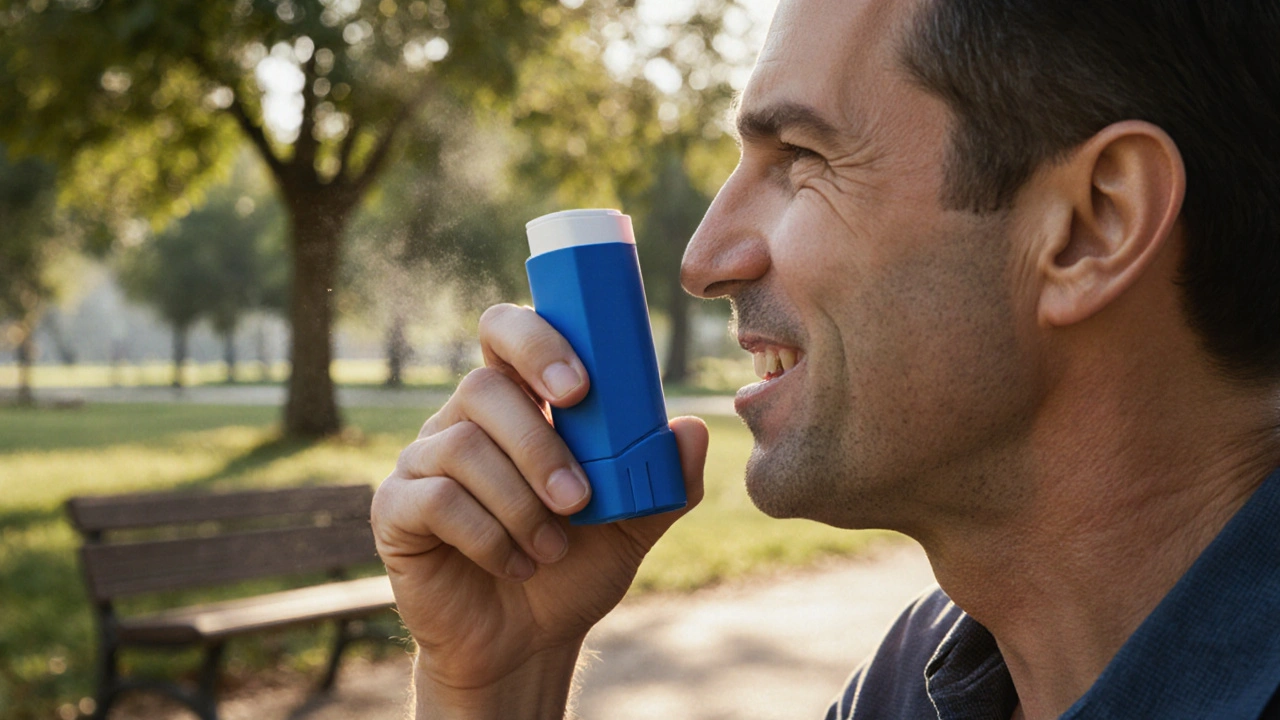When a sudden breath‑shortness hits, most people reach for their trusted rescue inhaler. Ventolin has been that go‑to for decades, but new drugs and devices have entered the market, promising faster relief or fewer side effects. This guide breaks down what Ventolin actually does, lines it up against the most common alternatives, and helps you decide which one fits your daily life.
Key Takeaways
- Ventolin (albuterol) is a short‑acting beta‑2 agonist (SABA) that opens airways within minutes and lasts about 4‑6hours.
- Levalbuterol (Xopenex) offers similar relief with potentially fewer heart‑related side effects.
- Ipratropium (Combivent) works on a different pathway, making it useful when SABAs alone aren’t enough.
- Montelukast (Singulair) and inhaled steroids such as fluticasone target inflammation rather than immediate bronchodilation.
- Choosing the right rescue medication depends on speed of onset, duration, side‑effect profile, cost, and personal response.
What is Ventolin (Albuterol)?
Ventolin is a brand‑name short‑acting beta‑2 agonist (SABA) inhaler that delivers the generic drug albuterol directly to the lungs. It works by binding to beta‑2 receptors on airway smooth muscle, causing a rapid relaxation that widens the airway. Onset is typically 5‑15minutes, peak effect occurs around 30minutes, and the relief lasts roughly 4‑6hours. The device uses a metered‑dose inhaler (MDI) or a dry‑powder inhaler (DPI) format, depending on the brand.
Top Alternatives at a Glance
Below are the most frequently mentioned rescue options. Each hits the lungs in a slightly different way, which can matter if you have a specific side‑effect concern or if your doctor recommends a combo approach.
| Medication | Class | Onset (min) | Duration (hrs) | Typical Side Effects |
|---|---|---|---|---|
| Ventolin (Albuterol) | SABA | 5‑15 | 4‑6 | Tremor, rapid heartbeat |
| Levalbuterol (Xopenex) | SABA (R‑enantiomer) | 5‑10 | 4‑6 | Less tachycardia, mild tremor |
| Ipratropium (Combivent) | Anticholinergic | 15‑30 | 6‑8 | Dry mouth, cough |
| Montelukast (Singulair) | Leukotriene receptor antagonist | 30‑60 | 24+ | Headache, rare mood changes |
| Fluticasone (Flovent) | Inhaled corticosteroid | 30‑60 | 24+ | Oral thrush, hoarseness |
How Levalbuterol (Xopenex) Stacks Up
Levalbuterol is the R‑enantiomer of albuterol, meaning it’s the “right‑handed” version of the same molecule. Studies from 2023 show it achieves comparable bronchodilation while triggering about 30% fewer heart‑related side effects. The trade‑off is a slightly higher price tag, especially for brand‑name versions.
For patients who experience jittery palms or palpitations after using Ventolin, a switch to Xopenex can make the rescue experience feel smoother. However, insurers often treat it as a specialty drug, so you may need prior authorization.

Ipratropium (Combivent) - The Non‑Beta‑Agonist Option
Ipratropium belongs to the anticholinergic class, blocking muscarinic receptors that cause airway constriction. It works slower than a SABA-usually 15‑30minutes-but its effects linger for up to eight hours. Because it doesn’t stimulate the heart, it’s a good backup for people who can’t tolerate beta‑agonists.
Combivent combines ipratropium with albuterol, giving you the rapid kick of a SABA plus the longer‑lasting anticholinergic support. Many pulmonologists prescribe it for chronic obstructive pulmonary disease (COPD) patients who also have asthma, but it’s less common as a sole rescue for mild intermittent asthma.
Anti‑Inflammatory Alternatives: Montelukast and Inhaled Steroids
While SABAs act like an emergency brake, anti‑inflammatory meds help prevent the engine from overheating in the first place.
Montelukast blocks leukotrienes, chemicals that cause airway swelling and mucus production. It’s taken as a once‑daily tablet, and its effect builds up over days, not minutes. For exercise‑induced asthma, a nightly dose can blunt the reaction without the jitter that inhalers sometimes cause.
Inhaled corticosteroids such as Fluticasone (found in Flovent) or Budesonide (Pulmicort) directly suppress inflammation at the airway level. They aren’t rescue meds, but using them regularly reduces the number of rescue inhaler episodes you need.
Choosing the Right Rescue: Decision Checklist
- Speed matters? If you need relief within seconds (e.g., acute wheeze during an attack), stick with a SABA like Ventolin or Levalbuterol.
- Heart sensitivity? Opt for Levalbuterol or add ipratropium if you notice palpitations after each puff.
- Cost constraints? Generic albuterol MDIs are the cheapest, widely covered by insurance. Branded alternatives may need a co‑pay.
- Frequency of use? More than two rescue doses per week signals poor control-time to talk to your doctor about stepping up a controller (ICS or LABA).
- Combination therapy? For patients with both asthma and COPD, Combivent offers a dual‑action approach.

How to Switch Safely Between Rescue Inhalers
Never just toss your old inhaler in the trash and start a new one without a plan. Here’s a simple three‑step routine:
- Ask your provider. Confirm the dosage (usually 90‑130µg per puff for albuterol; 45‑90µg per puff for levalbuterol).
- Practice technique. Even a perfect drug won’t work if you’re not inhaling correctly. Use a spacer if you have coordination issues.
- Monitor response. Keep a log for a week-note onset time, relief duration, and any side effects. Bring the log to your next visit.
Real‑World Scenarios
Case 1: The jittery runner - Maria, a 28‑year‑old marathoner, felt tremors after every Ventolin puff. Her doctor switched her to Levalbuterol and added a low‑dose inhaled steroid. Within two weeks, her post‑run breathlessness dropped and the shaking vanished.
Case 2: The COPD‑asthma overlap - James, 65, uses Ventolin but still coughs heavily at night. Adding ipratropium (via Combivent) gave him a longer night‑time window, reducing his nighttime inhaler use from four to one puff.
Case 3: The cost‑conscious teen - Aisha, 16, relies on school health services that provide generic albuterol MDIs free of charge. She avoids Levalbuterol because her insurance classifies it as “non‑formulary”. Her doctor emphasizes proper inhaler technique to maximize the cheap rescue’s effectiveness.
Bottom Line Checklist for Everyday Use
- Know your inhaler’s class (SABA vs anticholinergic vs anti‑inflammatory).
- Check the onset and duration before choosing for an activity (sports, travel, night‑time).
- Watch for side effects: tremor = beta‑agonist, dry mouth = anticholinergic, sore throat = steroid.
- Keep a backup inhaler of the same type in a different location (work, gym, car).
- Schedule a review with your clinician every 6‑12months or sooner if you need more than two rescue doses a week.
Frequently Asked Questions
Can I use Ventolin and Levalbuterol together?
Usually there’s no benefit to stacking two SABAs, as they act on the same receptors. If you need extra relief, doctors often add a different class, like ipratropium, rather than a second SABA.
Is it safe to use a rescue inhaler multiple times a day?
Short‑acting inhalers are safe for occasional use, but using them more than two times a week signals inadequate long‑term control. Talk to your doctor about adding a controller medication.
Why does my heart race after a puff?
Beta‑2 agonists also stimulate beta‑1 receptors in the heart, leading to tachycardia. If this bothers you, ask about Levalbuterol or an ipratropium‑containing combo.
Do inhaled steroids replace the need for a rescue inhaler?
Inhaled steroids reduce inflammation and the frequency of attacks, but they don’t act fast enough to relieve an acute bronchospasm. Most patients still keep a rescue inhaler on hand.
Can I use a spacer with a dry‑powder inhaler?
Spacers are designed for metered‑dose inhalers. For dry‑powder devices, the best practice is a proper, steady inhalation technique without a spacer.


Kevin Galligan
October 12, 2025 AT 03:48Wow, another deep dive into rescue inhalers-just what my weekend needed. 🙄 If you thought Ventolin was the only hero, think again; the market's got a whole squad now. Choose wisely, or you'll be shaking like a leaf at the next marathon. 😜
Dileep Jha
October 29, 2025 AT 11:28While the overview is exhaustive, it glosses over the pharmacodynamic intricacies that differentiate albuterol from its R‑enantiomer. The ligand‑receptor affinity curves reveal a subtle, yet clinically relevant, divergence in β2‑adrenergic activation thresholds. Moreover, the nebulization particle‑size distribution merits a dedicated subsection, given its impact on peripheral airway deposition. One must also consider the off‑target adrenergic cross‑talk that can precipitate tachyarrhythmias in susceptible phenotypes. Finally, the cost‑effectiveness analysis should integrate quality‑adjusted life‑years to reflect true therapeutic value.
Michael Dennis
November 15, 2025 AT 20:08Having perused the exhaustive comparison, I find myself compelled to point out several oversights that undermine its utility. First, the pharmacokinetic nuances of albuterol versus levalbuterol are reduced to a simplistic “fewer side effects” claim, ignoring enantiomeric bioavailability data. Second, the cost analysis neglects regional formulary variability, which can swing the price differential dramatically. Third, the discussion of ipratropium fails to address its limited efficacy in pure allergic asthma, a point well documented in the 2022 GINA guidelines. Fourth, the table omits the newly approved ultra‑rapid SABA, which boasts an onset under five minutes. Fifth, the narrative assumes that all patients have equal access to spacers, an unrealistic premise in low‑resource settings. Sixth, the article does not explore the impact of inhaler technique education on clinical outcomes, despite robust evidence supporting its importance. Seventh, the side‑effect profile for montelukast is presented without mentioning the black‑box warning for neuropsychiatric events. Eighth, the claim that inhaled corticosteroids “don’t replace rescue inhalers” is tautological and adds no value. Ninth, the checklist redundantly repeats “speed matters” already covered in the earlier sections. Tenth, the piece glosses over the potential for tachyphylaxis with frequent SABA use, a concern for high‑frequency asthmatics. Eleventh, the recommendation to “keep a backup inhaler” lacks guidance on storage conditions that preserve drug stability. Twelfth, the reliance on generic albuterol as the cheapest option ignores the recent price hikes observed in the United States. Thirteenth, the article could benefit from a decision‑tree flowchart to aid clinicians in real‑time prescribing. Fourteenth, the absence of patient‑reported outcome measures limits the applicability of the comparison. Fifteenth, the reference list is conspicuously absent, making verification impossible. Finally, while the tone strives for neutrality, occasional subjective language (“the go‑to”) subtly biases the reader toward Ventolin. In sum, the guide provides a surface‑level overview but falls short of the depth required for informed clinical decision‑making.
Blair Robertshaw
December 3, 2025 AT 04:48Nice try, but this piece is riddled with half‑baked facts and its tone is all over the place. The author definitely missed the mark on the ipratropium section – it’s not a miracle drug and the wording is just plain lazy. Also, the cost stuff is totally off‑base, you can’t just say "cheapest" without looking at local pricing.